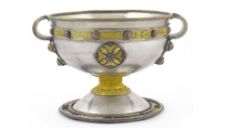From Greece to Japan
The mouth of the vase reveals even smaller details. There the skills of shosen enamelling are utilized, which correspond to the lower patterns, using a combination of harmonious colors like brown, green, and blue. The blue color is also used on the inside of the vase. The techniques of cloisonné were used in Mycenaean and ancient Greek culture.
In ancient Greece, artisans soldered wires to metal bodies and then applied enamel, a compound made of sand, flint, soda, and lead to fill the recessed areas. After such objects were fired at very high temperatures in a charcoal-fueled kiln, the enamel compound fused and became a glossy, glass-like texture.
Before the 16th century, very few examples of enamelware could be found in Japan. The craft became popular in Japan after the artist Hirata Hikoshiro (1803–83), better known as Dōnin, created a cloisonné work for a lord. Dōnin studied and imitated the ways of Chinese cloisonné. Eventually, he brought the secret production method to Japan and became well-known for creating decorative sword fittings while keeping his cloisonné production process a secret.
After a century, another Japanese artist named Kaji Tsunekichi (1803–83) purchased a Chinese cloisonné object and sought to unravel its mysteries by breaking it apart on purpose. He became known as the “Father of Modern Japanese Cloisonné” and trained many artists, creating a cloisonné community. Shippō is the Japanese term for objects made in imitation of Chinese cloisonné items. It relates to the seven treasures referenced in ancient Buddhist texts that appear on many Chinese cloisonné vessels: gold, silver, pearl, crystal, agate, lapis lazuli and coral.
So, who made our pair of vases?

](https://micrio.thingsthattalk.net/OrNiP/views/max/128x128.jpg)
](https://micrio.thingsthattalk.net/RNphd/views/max/206x128.jpg)